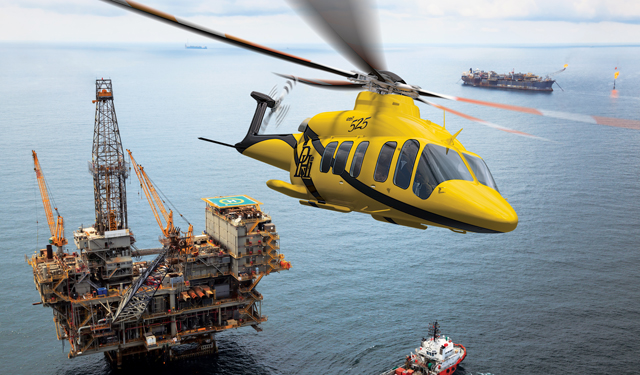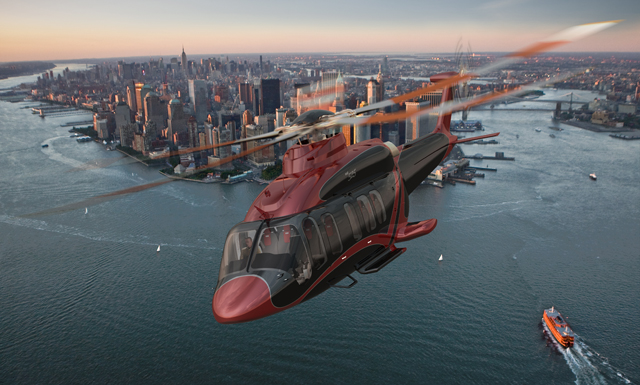Work on the Bell Helicopter 525 Relentless is accelerating at the company’s assembly plant in Amarillo, Texas, as the third flight-test vehicle (FTV) nears completion and the first two production-representative examples also begin to take shape.
Two of the five prototypes are already well into developmental testing, having first flown on 1 July and 21 December of 2015, respectively. Those initial aircraft (N525TA and N525BK), flew during a pre-Heli-Expo media tour of Bell’s XworX facility in Arlington, Texas on 16 February, adding more flight time to the 125h already recorded. FTV-2 will be on display at the convention in Louisville, Kentucky this week.
Meanwhile at the final assembly and checkout centre in Amarillo, workers are being re-allocated from Bell's military business where falling production volumes have created slack in the system.
Once dedicated solely to military projects, the commercial 525 has become the poster child for Bell’s “balanced business” approach to manufacturing at Amarillo, where experienced workers shift between programmes wax and wane, or are terminated altogether.
The expansive Amarillo site simultaneously produces the V-22, AH-1Z, UH-1Y, 525 and more recently, the V-280 Valor technology demonstrator, and is standing up a new customer delivery centre sponsored by the local government.

Bell 525 FTV-2 takes off at XworX in Arlington, Texas on 16 February
James Drew/Flight International
Bell 525 assembly manager Dave Dennison said during the factory tour that Relentless production begins at a rate of one aircraft per month, and assembly of the final three flight-test and certification aircraft is already well underway, as is the construction of extra airframes for structural fatigue analysis and bird strike trials.
Dennison says the first and second customer aircraft (MSN 62016 and 62017) have also entered the early stages of assembly, for delivery shortly after type certification in 2017.
FTV-3 will fly in March or April and will be committed to load testing as the most "heavily instrumented" aircraft of the fleet.
Currently, testing focuses on validation of the design as anticipated in computer models and the system integration laboratory, as well as flight envelope expansion. Bell engineers are making final design tweaks to reduce drag and improve performance before locking in the final configuration for type certification.
FTV-4 (MSN 62014) and FTV-5 (62015) will join the 1,500h flight test campaign in the third quarter and will be heavily involved in the certification of mission kits. Those two aircraft are as close to the final configuration as possible and will eventually be sold, Dennison says. They are also the first to be "marinised" to cope with operations in corrosive sea environments.

Bell Helicopter
Introduced at Heli-Expo 2012 as the first commercial fly-by-wire helicopter, Relentless is Bell’s answer to other super-medium challengers such as the Airbus Helicopters H175 and AgustaWestland AW189, but it also believes it can take market share from 11t-class helicopters like the H225 and Sikorsky S-92.
The 9t maximum take-off eight aircraft has triple-redundant systems and is powered by two GE Aviation CT7-2F1 engines. Programme officials say the aircraft’s new composite rotor blade design has already proven itself in testing and will likely enable the 525 to exceed its advertised cruise speed of 155kt (287km/h).
While Bell’s 525 production, development and test teams in Amarillo, Arlington and Mirabel in Canada are making good progress, some market analysts worry that sales teams seeking Relentless orders in the overcrowded and underperforming offshore oil and gas segment will struggle to keep up.
In 2011, when Bell Helicopter first began designing the 525 Relentless with the help of potential buyers, the company imagined delivering aircraft solely to offshore oil and gas customers for the first year.
But today, with oil prices hovering between $30 and $50 per barrel, that seems unlikely. Instead, Bell’s sales team is turning to a burgeoning executive transport market to fill production slots. It is even bringing forward certification of VIP niceties like plush interiors and high-speed satellite communications so those configurations are available to business customers from “day one” of delivery in 2017.
Programme officials believe it is too early to propose military derivatives, but with specifications comparable to the Sikorsky UH-60 Black Hawk, those discussions have taken place and some company-held conceptual drawings have already been circulated internally.
In a sign of the times, Petroleum Helicopters International (PHI) is no longer the 525’s launch customer; something Bell didn't foresee in 2012 when the Relentless was unveiled in PHI's yellow and black livery.
Instead, Middle Eastern fleet operator Abu Dhabi Aviation will take the initial delivery – as the first deposit holder, with orders for 10 aircraft per a letter of intent (LoI) signed in February 2014.
Former vice-president of Bell commercial programmes and recently appointed Relentless sales chief Larry Thimmesch says the 525 will be one of the top benefactors of the inevitable oil rebound, and in the meantime, the VIP market segment is showing promise.
Bell will certify 52 or 53 mission aircraft modifications initially, he says, most relating to offshore oil and gas operations as well as search-and-rescue (SAR). Proposed VIP configurations are being "pushed left" to be ready for prospective business clients as soon as possible.

Bell Helicopter
Although industry analysts doubt the nascent emergency medical services (EMS) and business markets can fully substitute for the dramatic dip in offshore oil and gas orders, Bell isn't slowing down.
The company launched three new products in the last five years — the 525, 505 Jet Ranger X and V-280 Valor — as it seeks to reclaim dominance of the rotorcraft business from its European rivals.
“It’s the right product for the future market in all segments,” says Thimmesch. “You never pick an insertion point in the market, because it ebbs and flows in all segments and it’s going to enter at an ebb in the oil and gas market. What that has done is change out near-term strategy, but certainly not in the long term.”

James Drew/Flight International
Matthew Hasik, executive vice-president of Bell’s commercial business, says Relentless comes to market as the only triple-redundant fly-by-wire commercial aircraft and it delivers “heavy-class capability at medium-class cost” – although he won’t divulge the list price.
“We’re not going out there to be a low-cost acquisition aircraft; we’re going out there to be the safest and lowest operating cost,” adds Thimmesch. “That’s another way of saying, I can’t tell you right now.”
Hasik says anyone who plays in oil and gas market has seen these cycles before and the segment will eventually rebound.
"As folks come to understand what this capability is all about, the interest and demand in the product will be quite strong,” he says. “The 75 LoIs today are just the start."
Source: FlightGlobal.com


























